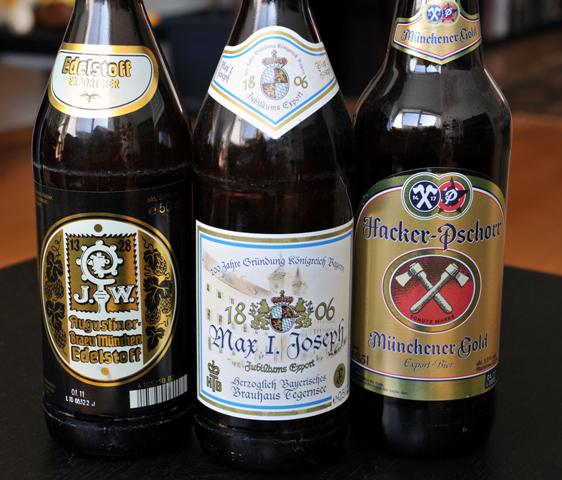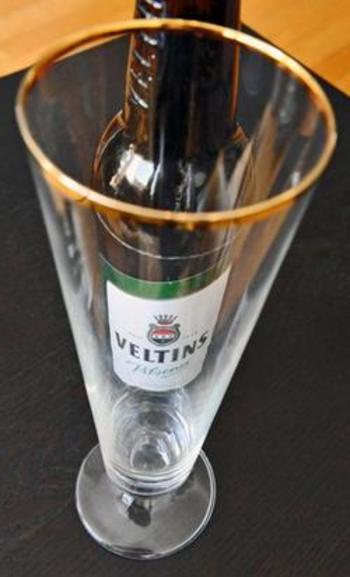Veltins Pilsner and the Export Beers
 Sunday, March 13, 2011 at 12:00
Sunday, March 13, 2011 at 12:00 As we didn't have enough German Pilsners available in my Munich supermarket, we included three Exportbier in this bracket. (You can find some other pilsners if you go to a beer store, and you can find a few Czech pilsners in my market, but we didn't have 16 German Pilsners in my store).
First, what is an Exportbier?
It's exactly as it sounds, but what was considered an Export was anything that was exported to another city. The realities of transportation prior to engines and refrigerating meant that the beer had to be brewed slightly differently to survive the journey. An exportbier is still a lager (bottom-fermented, etc), but it is brewed with a higher original wort (12-14% gravity) than a Pils or Helles (typically 11-12% gravity). This also results in a beer with a slightly higher alcohol content (5% vs the usual 3.5-4%)). Often the beer was diluted with water once it reached its destination. Thanks to the higher alcohol content, the beer had both a longer shelf life and lower transportation costs.
For many years (until the 1970s), Exportbier was one of the most popular varieties in Germany, when it was overtaken by the Pils. It's important to note that there are two different types of German Exportbier, as well as a more rare Vienna-style Export:
1) Dortmunder Exportbier is the most well-known - It's a pale lager brewed in the Dortmund area since the mid-1800's. Dortmunder Exportbier became the favorite of the region's industrial workers, as the regions coal and steelworkers needed a good brew to drink. Though it still has a hoppy taste, it has a strong malty and slightly sweeter taste, too.
2) Munich Exportbier - This is what we're trying today. The Munich style typically is darker than a Dortmunder, due to darker malt and higher temperatures in the kiln. This also gives it a slightly caramel flavor. Not surprisingly, the Munich Exportbier is less strongly hopped than the Dortmunder.
So, onto the beers....
 In this bracket, we also have our last Pilsner, Veltins Pilsener. Recall that Veltins, the 7th largest brewer, is the beer of FC Schalke and runs a 5km beer pipeline from the brewery to the taps at the arena. Veltin's primary brews a pilsner style beer, though they do also sell light, alcohol free, radler (beer/lemon soda mix), alcoholfree malt, and the V+ range of flavored beers as is very trendy today. Veltins brewery began in 1824, brewing the usual beer types. In 1926, it decided to focus only on the pilsner style of beer.
In this bracket, we also have our last Pilsner, Veltins Pilsener. Recall that Veltins, the 7th largest brewer, is the beer of FC Schalke and runs a 5km beer pipeline from the brewery to the taps at the arena. Veltin's primary brews a pilsner style beer, though they do also sell light, alcohol free, radler (beer/lemon soda mix), alcoholfree malt, and the V+ range of flavored beers as is very trendy today. Veltins brewery began in 1824, brewing the usual beer types. In 1926, it decided to focus only on the pilsner style of beer.
Here, Veltins goes up against Hacker-Pschorr's Münchener Gold Export Bier. The Münchener Gold was first brewed in the late 1800s, and then was brought back in 2005.
While the Veltins is an excellent Pils, we preferred the maltiness of the export beer. Just a matter of personal preference...
In the next round, we get a fairer competition, as it's between two Munich Export Beers: Augustiner Edelstoff Exportbier and Tegernsee's Max I. Joseph Jubiliäms Export. ("Edel" means "noble", meaning that this beer uses the "noble ingredients." You often will hear of "noble hops" in Bavaria).
This beer from the Tegernseer brewery was brewed in 2006 to commemorate the 200th anniversary of the founding of the Kingdom of Bavaria by Max(imilian) I. Joseph. King Max, as he was known, also purchased the Tegernsee monastery and brewery from its baron owner in 1817, a decade or so after the secularization of Bavaria. Under his ownership, Tegernsee became a cultural and economic center. Hence the beer to honor King Max and Bavaria.
The Augustiner was a relatively light colored exportbeer. This was almost a tie - Augustiner had slightly more body (due to a fizzier feeling in the mouth). The Tegernsee was a bit sweeter, and we didn't love the feeling of its carbonation.
Then we have Augustiner vs Hacker-Pschorr to decide who goes on to the Sweet Sixteen. Again, the Augustiner had what we call "more body." It just felt like a more solid beer and had a very pleasant level of carbonation. Also, it had the great hint of malty taste, but was not too sweet - it was just a great balance between maltiness and hoppiness. The Hacker-Pschorr, on the other hand, tasted flat and sweet compared to the Augustiner.

 Frau A ...
Frau A ...  Post a Comment
Post a Comment  Beer,
Beer,  Germany & German Culture tagged
Germany & German Culture tagged  beer,
beer,  beer bracket,
beer bracket,  beer tournament ...
beer tournament ...  Print Article
Print Article  Email Article
Email Article 




Reader Comments